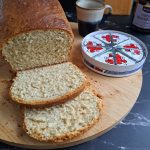
Bread with seeds recipe
Bread with seeds is a twist to the traditional loaf, incorporating a variety of seeds such as pumpkin, sunflower, and flax. These seeds not only enhance the texture but also provide a satisfying crunch and nutritional value to the bread.
Ingredients
1 cup = 250ml
- 2 cups 280gms All-purpose flour/Maida (Vetemjöl special)
- ¾ cup 105gms Wheat flour (Vetemjöl fullkorn)
- ⅓ cup 28gms Oats
- 4 tbsp of mixed seeds (Flax, pumpkin, sunflower)
- 1 tsp salt
- 2 tbsp sugar
- 2 tsp instant-dried yeast
- 200 to 230 ml milk
- 3 tbsp or 43gms of butter salted or unsalted
- 1 room-temperature egg
Instructions
Preparing the dough
- Grind the oats and the mixed seeds in a blender or a food processor and keep them aside.
- In a stand mixer bowl or a mixing bowl, add the all-purpose flour (Vetemjöl special), wheat flour (Vetemjöl fullkorn), ground oats, mixed seeds, egg and salt. Mix everything until well combined.
- Now add the sugar, and instant dried yeast and combine everything well. (Read more about the yeast in the introduction)
- Melt butter in a pan add the milk and combine. Warm it to around 35 to 40 degrees. If you don't have a thermometer, use your wrist to test the temperature. If it feels very warm on your wrist, it's ready.
- Add this to the dough and knead the dough in a stand mixer for about 10 minutes. If you are kneading by hand, knead it to a smooth dough and it may roughly take around 20 to 25 minutes.
Windowpane test
- The windowpane test is the best way to test whether the dough is sufficiently kneaded. Take a small ball of the dough and stretch it into a square. Keep on stretching until it becomes a thin film in the middle without breaking. The dough must be thin enough to pass light through it. If it is obtained without tearing, your dough is properly kneaded.
- If your dough breaks easily, keep kneading and repeat the test in a few minutes.
First proofing
- Once the dough passes the windowpane test, remove the dough from the stand mixer bowl and transfer it to a large oiled bowl. Coat the dough with oil on all sides.
- Cover the dough with a plastic wrap or kitchen towel and let it proof in a warm place for about 1 to 2 hours. (Varies depending on the temperature). You can also place it inside the oven with only the lights turned on in cold places.
Shaping the bread
- After the dough is doubled in size, transfer it to a lightly floured countertop or a silicon mat and flatten it gently. Place the smooth side facing down, start rolling it into a log like and seal the edges well.
- Place this on a parchment-lined or well-greased loaf pan with a sealed side facing down.
Second proofing
- Once it is shaped, cover it again with a plastic wrap or kitchen towel and keep it in a warm place for the second proofing. After 1 to 2 hours, the bread rises and now it's time to bake the bread.
Baking and cooling the bread
- Preheat the oven to 200 degrees Celsius. Brush the top of the bread with milk or egg mixed with 1 tbsp of milk or water. Pop the tray into the oven and bake for about 30 to 35 minutes.
- You may have to cover the top of the bread with aluminium foil halfway through if the top of the bread gets too dark.
- After the bread is done baking remove it from the oven and smear butter on the top. After 5 minutes transfer it to a cooling rack and allow it to cool completely to get clean slices of bread.
Notes
Tips
It is essential to use a lukewarm butter-milk mixture.
The amount of milk may vary depending on the flour used. So add the liquid mixture little by little until the dough comes together and is non-sticky.
Add a teaspoon of salt to the dough if you are using unsalted butter.
Make sure the dough passes the windowpane test.
If you are skipping the egg add ¼ cup plus 2 to 3 tbsps of more milk.
The mixed seeds can be replaced with any nuts or seeds.
Always check the expiration date of the yeast on the package. Avoid using expired yeast.
If you are using active dry yeast, don´t forget to activate it before adding it to the dough mixture.
Add 2 tsp of active dry yeast to a half cup of lukewarm milk, and add 1 tbsp of sugar. Mix everything well and leave it aside for 10 minutes for the yeast to bloom.
This can be done for the instant yeast as well to make sure you are using good yeast. If you are sure your yeast is fresh, then you can skip this step for the instant yeast.
Cool completely to get clean slices of the bread.

